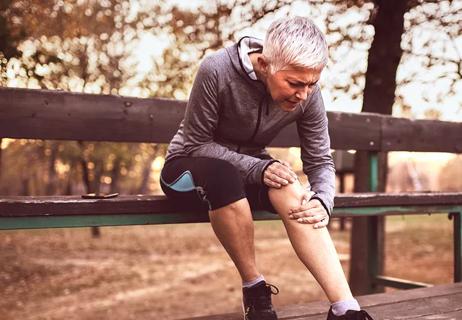Build your body's 'natural knee brace'

You get up out of your car, walk into work and climb your office stairs. After work, you stand in a long line at the grocery store, patiently waiting to check out. Then on the weekend, you climb aboard your bicycle and ride several miles.
Advertisement
Cleveland Clinic is a non-profit academic medical center. Advertising on our site helps support our mission. We do not endorse non-Cleveland Clinic products or services. Policy
All of these activities have one thing in common: They force you to engage your quadriceps muscles, one of the key muscle groups necessary for knee function.
In fact, your quadriceps, or quads, play a vital role in nearly all of your leg movements, so it’s important to keep them strong and flexible. Having weak quads not only can diminish your knee’s function, but research shows it also may put you at risk for knee cartilage loss, the hallmark trait of knee osteoarthritis.
“The quadriceps are the primary muscles that help support the knees. If you have weakness in your quads, that can lead to a degree of instability in your knees,” says physical therapist Tim Bungo, PT, SCS.
If there’s instability in your knees, that’s likely to lead to a greater amount of wear and tear within the joint.
Improving the strength and flexibility of your quadriceps can go a long way toward boosting your knee function, but it’s important to do the right exercises in the right amounts, Bungo cautions. And be sure to focus on other muscle groups that support your knee and help you carry out your activities of daily living.
The quadriceps are made up of four muscles on the front of your thigh. Their main function is to extend, or straighten, your knee, and they’re involved in several important tasks of daily living, such as transitioning from sitting to standing and supporting your knees while you’re standing or walking.
Advertisement
In a recent study, researchers performed isometric strength testing on 163 people, ages 40 to 79, and categorized them as having normal or weak quadriceps. About 12% of the participants had quadriceps weakness when the study began, and they were more likely to report higher levels of knee pain.
Over a mean follow-up period of 3.3 years, 15.5% of the participants experienced loss of knee cartilage, as viewed on magnetic resonance imaging (MRI). This loss of cartilage occurred in 44% of those with quadriceps weakness, compared with 11.7% of those with normal quad strength — a threefold increased risk of cartilage loss in those with quad weakness — the study authors reported.
“With the quads being the main muscles that support the knee joint, if you don’t have good muscle strength there, that can lead to further problems,” Bungo adds.
The quadriceps may be the body’s “natural knee brace,” as the study authors referred to them, but they’re not the only muscles that are critical for good knee function. Equally important are the hamstrings on the back of your thigh and the gluteal muscles of the buttocks. Like the quadriceps, these muscles not only help you sit and rise from a seated position, but they also enable you to complete other everyday activities. These include climbing stairs, lifting heavy objects and getting into and out of your vehicle.
Unfortunately, many people tend to focus on increasing quad strength and flexibility, at the expense of their hamstrings and gluteal muscles, Bungo says. “We see that a lot, and that creates a muscle imbalance, which can predispose you to injury. It’s important to have that balance.”
Several complications can arise from having weakness or poor flexibility in your quads, hamstrings and gluteal muscles. For instance, you might alter your gait to compensate for these deficiencies, and in doing so, you can put stress on other parts of your body, such as your hips and lower back. Plus, poor leg strength can impair your balance and increase your risk of debilitating falls.
“Balance is a combination of lower-body strength and your sense of balance,” Bungo explains. “Knee weakness, and lower-extremity weakness in general, absolutely can increase your fall risk.”
Bungo recommends a four-pronged strategy to promote good knee function and help reduce wear and tear on your knees:
Advertisement
“We’ve definitely seen lots of success stories and improvements in function. Folks are able to get back to tolerating a round of golf or being able to play tennis,” he says. “Building strength to create a more stable joint can reduce pain and improve function. You’re probably not going to see yourself get better if you’re not doing stretching or strengthening or modification of your activities.”
Here, Bungo recommends five easy exercises to improve the strength and flexibility of your quadriceps and other muscles that support your knees:
Advertisement
This article originally appeared in Cleveland Clinic Men’s Health Advisor.
Advertisement
Learn more about our editorial process.
Advertisement

Work on building strength and flexibility to keep the joints moving

Understanding your options

Most recommended precautions center around minimizing bruising or swelling

Even one drink can have an impact on your cognitive function leading to slurred speech, blurred vision and impaired memory

Understand who may (and may not) benefit

Lorem ipsum dolor sit amet. Et odio Quis vel ipsam omnis eum alias deleniti et placeat impedit non voluptas galisum hic autem enim et cupiditate aliquid. Est beatae quidem non facilis autem ut commodi nisi aut tempore rerum et dolores voluptatem cum enim optio id sapiente quasi. Ad laboriosam officiis 33 cupiditate sequi ea voluptatum consectetur qui necessitatibus voluptate et quasi doloremque et facere explicabo quo explicabo officia

Type 2 diabetes isn’t inevitable with these dietary changes

Applying a hot or cold compress can help with pain